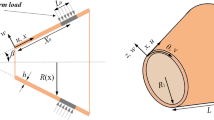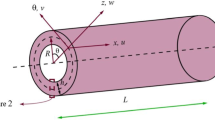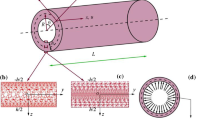Abstract
This paper analyzes the free and forced vibrations of three-dimensional graphene foam (3D-GrF) truncated conical microshells. Different distributions of the 3D-GrF are considered. In accordance with Love’s thin shell theory and the modified couple stress theory, governing equations which consider the size effect are established by the Hamilton’s principle. Then, vibration characteristics of 3D-GrF truncated conical microshells are studied through the Galerkin’s method. A series of results show that the apex angle, the 3D-GrF distribution, the foam coefficient, the circumferential wave number and the material length scale parameter play important roles on vibration characteristics of the conical microshells.








Similar content being viewed by others
References
Wu Y, Yi N, Huang L, Zhang T, Fang S, Chang H, Li N, Oh J, Lee JA, Kozlov M (2015) Three-dimensionally bonded spongy graphene material with super compressive elasticity and near-zero Poisson’s ratio. Nat Commun 6:6141
Qin Z, Jung GS, Kang MJ, Buehler MJ (2017) The mechanics and design of a lightweight three-dimensional graphene assembly. Sci Adv 3(1):e1601536
Yavari F, Chen Z, Thomas AV, Ren W, Cheng H-M, Koratkar N (2011) High sensitivity gas detection using a macroscopic three-dimensional graphene foam network. Sci Rep 1:166
Xu X, Zhang Q, Yu Y, Chen W, Hu H, Li H (2016) Naturally dried graphene aerogels with superelasticity and tunable Poisson’s ratio. Adv Mater 28(41):9223–9230
Qiu L, Huang B, He Z, Wang Y, Tian Z, Liu JZ, Wang K, Song J, Gengenbach TR, Li D (2017) Extremely low density and super-compressible graphene cellular materials. Adv Mater 29(36):1701553
Sha J, Li Y, Villegas Salvatierra R, Wang T, Dong P, Ji Y, Lee S-K, Zhang C, Zhang J, Smith RH (2017) Three-dimensional printed graphene foams. ACS Nano 11(7):6860–6867
Lv L, Zhang P, Cheng H, Zhao Y, Zhang Z, Shi G, Qu L (2016) Solution-processed ultraelastic and strong air-bubbled graphene foams. Small 12(24):3229–3234
Strek W, Tomala R, Lukaszewicz M, Cichy B, Gerasymchuk Y, Gluchowski P, Marciniak L, Bednarkiewicz A, Hreniak D (2017) Laser induced white lighting of graphene foam. Sci Rep 7:41281
Ghazi A, Berke P, Kamel KEM, Sonon B, Tiago C, Massart T (2019) Multiscale computational modelling of closed cell metallic foams with detailed microstructural morphological control. Int J Eng Sci 143:92–114
Ghazi A, Tiago C, Sonon B, Berke P, Massart T (2020) Efficient computational modelling of closed cell metallic foams using a morphologically controlled shell geometry. Int J Mech Sci 168:105298
Redenbach C, Shklyar I, Andrä H (2012) Laguerre tessellations for elastic stiffness simulations of closed foams with strongly varying cell sizes. Int J Eng Sci 50(1):70–78
Shi X, Liu S, Nie H, Lu G, Li Y (2018) Study of cell irregularity effects on the compression of closed-cell foams. Int J Mech Sci 135:215–225
Wang C, Zhang C, Chen S (2016) The microscopic deformation mechanism of 3D graphene foam materials under uniaxial compression. Carbon 109:666–672
Wang YQ, Zhang ZY (2019) Bending and buckling of three-dimensional graphene foam plates. Results Phys 13:102136
Stölken JS, Evans A (1998) A microbend test method for measuring the plasticity length scale. Acta Mater 46(14):5109–5115
Liu D, He Y, Dunstan D, Zhang B, Gan Z, Hu P, Ding H (2013) Anomalous plasticity in the cyclic torsion of micron scale metallic wires. Phys Rev Lett 110(24):244301
Liu D, He Y, Tang X, Ding H, Hu P, Cao P (2012) Size effects in the torsion of microscale copper wires: experiment and analysis. Scr Mater 66(6):406–409
Şimşek M, Reddy J (2013) Bending and vibration of functionally graded microbeams using a new higher order beam theory and the modified couple stress theory. Int J Eng Sci 64:37–53
Yang F, Chong A, Lam DCC, Tong P (2002) Couple stress based strain gradient theory for elasticity. Int J Solids Struct 39(10):2731–2743
Lou J, He L, Wu H, Du J (2016) Pre-buckling and buckling analyses of functionally graded microshells under axial and radial loads based on the modified couple stress theory. Compos Struct 142:226–237
Ke L-L, Wang Y-S, Yang J, Kitipornchai S (2012) Free vibration of size-dependent Mindlin microplates based on the modified couple stress theory. J Sound Vib 331(1):94–106
Wang YQ, Liu YF, Zu JW (2019) On scale-dependent vibration of circular cylindrical nanoporous metal foam shells. Microsyst Technol 25(7):2661–2674
Sexton LT, Horne LP, Martin CR (2007) Developing synthetic conical nanopores for biosensing applications. Mol BioSyst 3(10):667–685
Lan W-J, Holden DA, Liu J, White HS (2011) Pressure-driven nanoparticle transport across glass membranes containing a conical-shaped nanopore. J Phys Chem C 115(38):18445–18452
Yan J, Zhang L, Liew K, He L (2014) A higher-order gradient theory for modeling of the vibration behavior of single-wall carbon nanocones. Appl Math Model 38(11–12):2946–2960
Ansari R, Rouhi H, Rad AN (2014) Vibrational analysis of carbon nanocones under different boundary conditions: an analytical approach. Mech Res Commun 56:130–135
Dehkordi SF, Beni YT (2017) Electro-mechanical free vibration of single-walled piezoelectric/flexoelectric nano cones using consistent couple stress theory. Int J Mech Sci 128:125–139
Mohammadi K, Mahinzare M, Rajabpour A, Ghadiri M (2017) Comparison of modeling a conical nanotube resting on the Winkler elastic foundation based on the modified couple stress theory and molecular dynamics simulation. Eur Phys J Plus 132(3):115
Zienkiewicz OC, Taylor RL, Zhu JZ (2005) The finite element method: its basis and fundamentals. Elsevier, Amsterdam
Park S, Gao X-L (2008) Variational formulation of a modified couple stress theory and its application to a simple shear problem. Zeitschrift für angewandte Mathematik und Physik 59(5):904–917
Magnucki K, Stasiewicz P (2004) Elastic buckling of a porous beam. J Theor Appl Mech 42(4):859–868
Magnucka-Blandzi E (2008) Axi-symmetrical deflection and buckling of circular porous-cellular plate. Thin Walled Struct 46(3):333–337
Jabbari M, Mojahedin A, Khorshidvand A, Eslami M (2014) Buckling analysis of a functionally graded thin circular plate made of saturated porous materials. J Eng Mech 140(2):287–295
Nieto A, Boesl B, Agarwal A (2015) Multi-scale intrinsic deformation mechanisms of 3D graphene foam. Carbon 85:299–308
Leissa AW (1973) Vibration of shells. Technical report NASA SP-288, National Aeronautics and Space Administration
Song Z, Zhang L, Liew K (2016) Dynamic responses of CNT reinforced composite plates subjected to impact loading. Compos B Eng 99:154–161
Wang YQ, Zu JW (2017) Vibration behaviors of functionally graded rectangular plates with porosities and moving in thermal environment. Aerosp Sci Technol 69:550–562
Irie T, Yamada G, Tanaka K (1984) Natural frequencies of truncated conical shells. J Sound Vib 92(3):447–453
Lam K, Hua L (1999) Influence of boundary conditions on the frequency characteristics of a rotating truncated circular conical shell. J Sound Vib 223(2):171–195
Tadi Beni Y, Mehralian F (2016) The effect of small scale on the free vibration of functionally graded truncated conical shells. J Mech Mater Struct 11(2):91–112
Acknowledgements
This research was supported by the National Natural Science Foundation of China (Grant nos. 11922205 and 11672071), LiaoNing Revitalization Talents Program (Grant no. XLYC1807026), and the Fundamental Research Funds for the Central Universities (Grant no. N2005019).
Author information
Authors and Affiliations
Corresponding author
Additional information
Technical Editor: José Roberto de França Arruda.
Publisher's Note
Springer Nature remains neutral with regard to jurisdictional claims in published maps and institutional affiliations.
Rights and permissions
About this article
Cite this article
Liu, Y.F., Ling, X. & Wang, Y.Q. Free and forced vibration analysis of 3D graphene foam truncated conical microshells. J Braz. Soc. Mech. Sci. Eng. 43, 133 (2021). https://doi.org/10.1007/s40430-021-02841-9
Received:
Accepted:
Published:
DOI: https://doi.org/10.1007/s40430-021-02841-9




